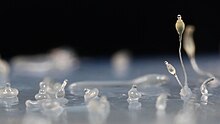The Conosa is one of three subphyla in the Amoebozoa. It is subdivided into two infraphyla – the Mycetozoa and the Archamoebae.[1][2]
- Mycetozoa: a group of slime moulds.
- Archamoebae: distinguishing mark: they have no mitochondria.
| Conosa | |
|---|---|

| |
| Dictyostelium discoideum | |
| Scientific classification | |
| Domain: | Eukaryota |
| Phylum: | Amoebozoa |
| Clade: | Evosea |
| Subphylum: | Conosa Cavalier-Smith, 1998 |
| Infraphyla | |
Conosa includes the species Dictyostelium discoideum and Entamoeba histolytica, among others.[3]
About 2000 species are known, and probably there are many more. Because these cells have few visible characteristics, they do look rather alike: "they exhibit few morphological traits that can be used as taxonomic characters".[2] As their molecular biology becomes known, many species may get split.
Related pages
changeReferences
change- ↑ Cavalier-Smith T 1998 (2007). "A revised six-kingdom system of life". Biol Rev Camb Philos Soc. 73 (3): 203–66. doi:10.1111/j.1469-185X.1998.tb00030.x. PMID 9809012. S2CID 6557779. Archived from the original on 2012-12-05. Retrieved 2016-02-23.
{{cite journal}}: CS1 maint: numeric names: authors list (link) - ↑ 2.0 2.1 Bapteste E; Brinkmann H. & Lee J.A. 2002; et al. (2002). "The analysis of 100 genes supports the grouping of three highly divergent amoebae: Dictyostelium, Entamoeba, and Mastigamoeba". Proc. Natl. Acad. Sci. U.S.A. 99 (3): 1414–9. doi:10.1073/pnas.032662799. PMC 122205. PMID 11830664.
{{cite journal}}: CS1 maint: multiple names: authors list (link) CS1 maint: numeric names: authors list (link) - ↑ Song J; Xu Q. & Olsen R. 2005; et al. (2005). "Comparing the Dictyostelium and Entamoeba genomes reveals an ancient split in the Conosa lineage". PLOS Comput. Biol. 1 (7): e71. doi:10.1371/journal.pcbi.0010071. PMC 1314882. PMID 16362072.
{{cite journal}}: CS1 maint: multiple names: authors list (link) CS1 maint: numeric names: authors list (link)